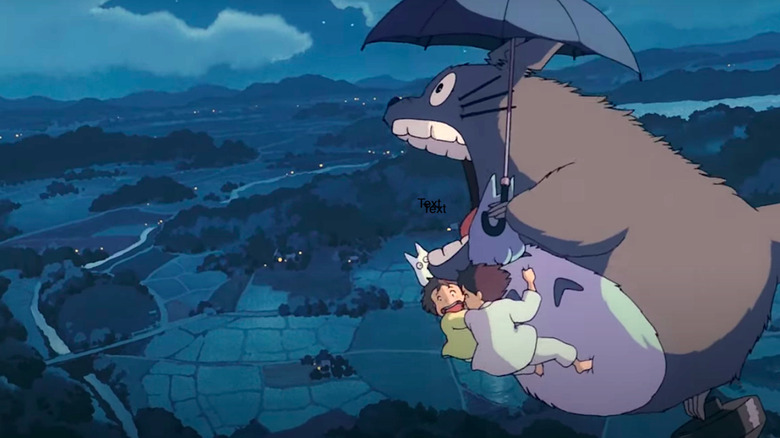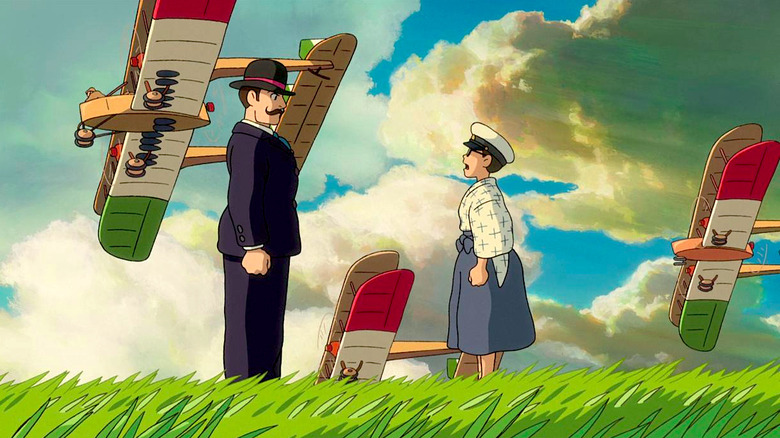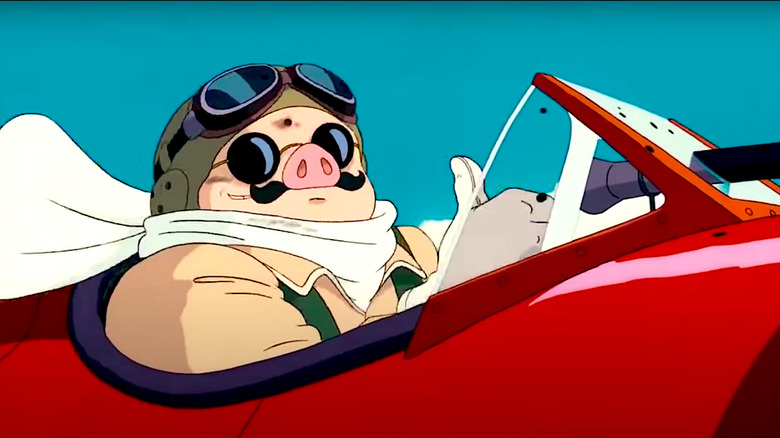The Common Theme That Runs Through Most Hayao Miyazaki Works
The scene that always gets me whenever I watch "My Neighbor Totoro" is the flying scene. You know the one, where Totoro, after helping grow the magical acorns in Mei and Satsuki's garden, flies over the landscape perched atop a magical spinning top while the girls cling effortlessly to his furry body. I love this scene for its magic and the freedom it evokes in its viewers, the flight over the girls' neighborhood encompassing all the wonderful possibilities of being a child in the world. It's a liberating scene meant to hold meaning for the fantastical events that the girls have just experienced unbeknownst to their father, and it's the sheer impossibility of soaring through the air in the middle of the night that brings levity to the moment.
"My Neighbor Totoro" is about many things — childhood, imagination, family, appreciation for the earth — and flight continually plays a significant role in conveying the importance of these themes throughout the film. In fact, this isn't the only of Hayao Miyazaki's films to incorporate flying into his vast, spiritual worlds. It is a theme that reoccurs over and over again throughout eight of his eleven films, and its importance to both the stories being told and to Miyazaki himself should not go unnoticed.
Miyazaki's love of flight
Miyazaki's fascination with flight goes all the way back to his childhood. In fact, he grew up around it since his father was the director of Miyazaki Airplane. The company, which was owned by Miyazaki's uncle, helped to manufacture parts for airplanes during World War II. This aeronautical influence followed Miyazaki throughout his childhood and into his adult life, and it had a profound effect on how he viewed both flight and the world as it shows up everywhere in his work today.
When we look at the films Miyazaki has created, nearly all of them feature flight in some particular way. The obvious examples are "Porco Rosso" which tells the tale of a bounty hunting pilot turned pig who chases "air pirates" by plane, and "The Wind Rises" which is an animated biographical account of Jiro Horikoshi, the man responsible for designing World War II Mitsubishi aircrafts. But flight exists in Miyazaki's other films in more creative ways, as well. Both "Howl's Moving Castle," and "Castle in the Sky" feature fantastical flying structures, and other films like "My Neighbor Totoro," "Spirited Away," and "Kiki's Delivery Service" incorporate flight in the characters themselves. Of course, there is some crossover of the types of flying that occur in Miyazaki's films — along with Kiki's ability to fly on broom, we also cannot forget Tombo's airship tragedy — showing that flying is not just about airplanes in a Miyazaki film. It is something even more special than technology, as it has the ability to transcend tech in order to be utilized by humans alone. Flying is everywhere when it comes to Miyazaki and his films, but why?
The meaning of the skies
Flight has always been fascinating to humans. It is one major thing that our bodies are not designed for. Eternally earthbound, we have searched for other ways to escape into the air, and eventually we invented the airplane which changed everything about how the world operates. In Miyzaki's worlds, many characters are blessed with the ability to fly whether it be through airship or some other form of magic, and always their ascent into the sky can be seen as symbolic of things much greater than just a desire to take flight.
The concept of flight often denotes possibilities as if the ability to get ourselves into the air paves the way to our success. Scenes like when the Totoro flies above the neighborhood with Mei and Satsuki or when Chihiro and Haku take to the skies in "Spirited Away" invoke a sense of possibility and wonder simply because the characters are very literally defying the laws of gravity. These scenes fill viewers up with feelings of happiness and hope, turning the sky into a beautiful realm in which magical things can happen. Flight in a Miyazaki film also seems to make a connection to childhood wonder as both Mei, Satsuki, and Chihiro are young girls who get to experience flight uninhibited by a machine. It's often said that children experience flying dreams more often than adults, so it's no wonder then that Miyazaki uses flight as a way to evoke the enchanted possibilities of growing up.
Flight isn't always positive in Miyazaki's films, however. Sometimes, as in "Castle in the Sky," the beautiful, flying thing like the city of Laputa gets hijacked into become a weapon of mass destruction. Oftentimes, there are sides to the airplanes taking to the skies like in "Porco Rosso" which shows Porco having to fight off evil air pirates, a clear delineation being made between good flight and bad. This divide between good and bad reminds us to be mindful of the ways we choose to use our newfound powers.
Miyazaki's love of flight is a perpetual theme in his films, and if we think about it in the context of the stories he is trying to tell us, we can see that the power and magic of aviation and flight is both to be treasured and feared.


